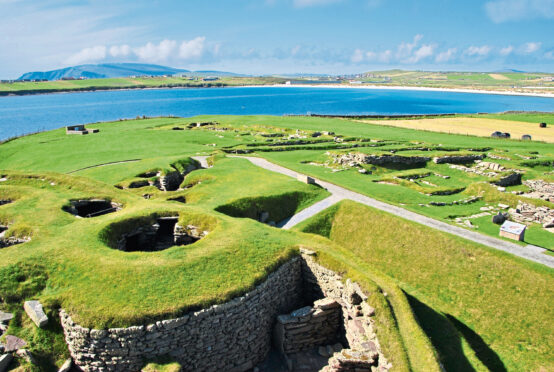
Scotland has some of the best-preserved ancient brochs, cairns and fortifications in the world. Here are five not to miss:
1 Cairnpapple Hill, West Lothian
Cairnpapple Hill lies in the middle of the Central Belt, not far from places where high finance is the daily norm.
Tucked away in the Bathgate Hills is a burial chamber with a history dating back more than 4,000 years – you can clamber inside with the use of a ladder and experience the stillness of this ancient tomb.
2 Edin’s Hall Broch, Abbey St Bathans, Borders
The double ramparts of Edin’s Hall Broch, sitting on top of a hill high above the Whiteadder Water are impressive, especially when you consider they date back up to 2500 years ago.
A walk up to the Iron Age hillfort from the village of Abbey St Bathans will test the leg muscles for just under an hour and emphasise the ingenuity of our ancestors.
This broch is a rare example in the Lowlands and its large size means that whoever had it built was a person of power. Today, it’s a good place to explore and stop for a snack.
3 Rough Castle, Near Falkirk
This is almost modern compared to others here, but still ancient. Construction began on the Antonine Wall around 142CE, and it stretches from Bo’ness on the River Forth to Old Kilpatrick on the Clyde.
Much of it consisted of a large ditch with fortifications such as Rough Castle.
It was the north-west frontier of the Roman Empire until it was abandoned around 160CE, and is still impressive. Look for pits which held stakes designed to impale would-be invaders. They were called “lilia” as Caesar thought they looked like lilies.
4 Jarlshof, Sumburgh, Shetland
Jarlshof was in use by humans for more than 4000 years. Up until the 1600s it was a place of homes, farming and ritual. A partially-ruined Iron Age broch sits near a Bronze Age smithy, as well as a Norse longhouse.
This is a complex site and a 16th-century laird’s house is also there to be explored, dominating the surrounding landscape.
When you add in the dramatic headland on which it all lies, this makes for an exciting place to experience. It was Sir Walter Scott who named the site Jarlshof, or “earl’s house”, in his novel The Pirate. Its proper name is Sumburgh.
5 Cairn o’Get, Caithness
Caithness is one of the best places in Scotland to visit prehistoric sites – there are so many that they appear round almost every corner – and this burial chamber is one of the best.
The chamber dates back more than 5000 years, and you can walk through the entrance and be transported back to the time of early man, when family burials were a cornerstone of the culture.
Although the roof is missing, the workmanship is still there to be admired – as well as the peace and tranquillity of this unspoiled corner of Scotland.

Enjoy the convenience of having The Sunday Post delivered as a digital ePaper straight to your smartphone, tablet or computer.
Subscribe for only £5.49 a month and enjoy all the benefits of the printed paper as a digital replica.
Subscribe